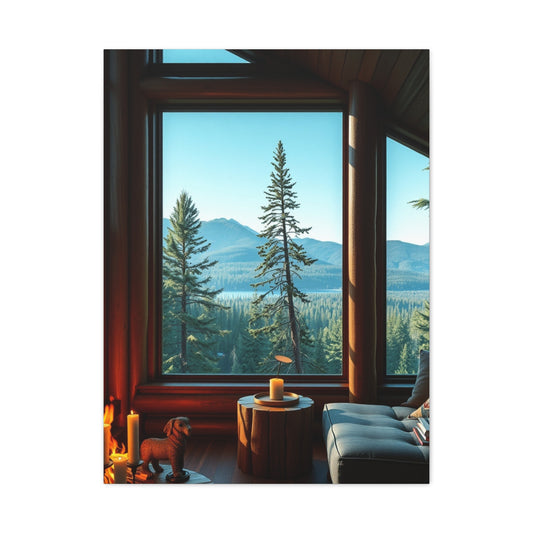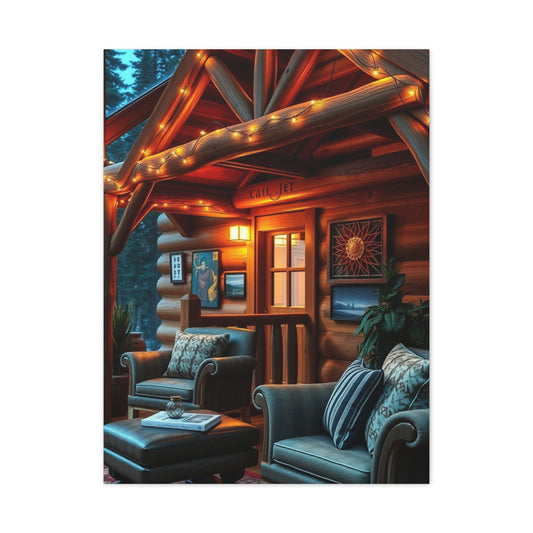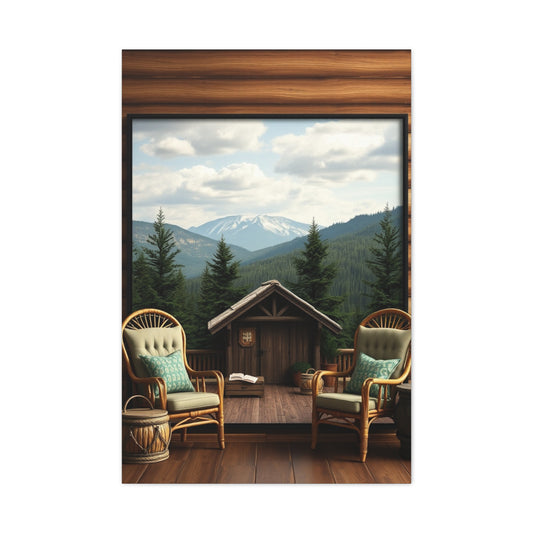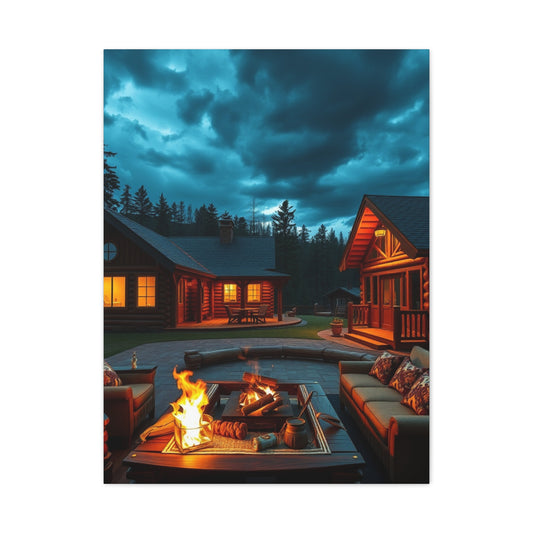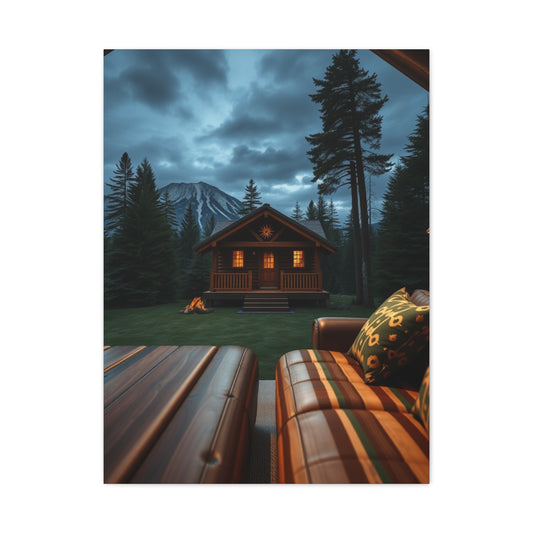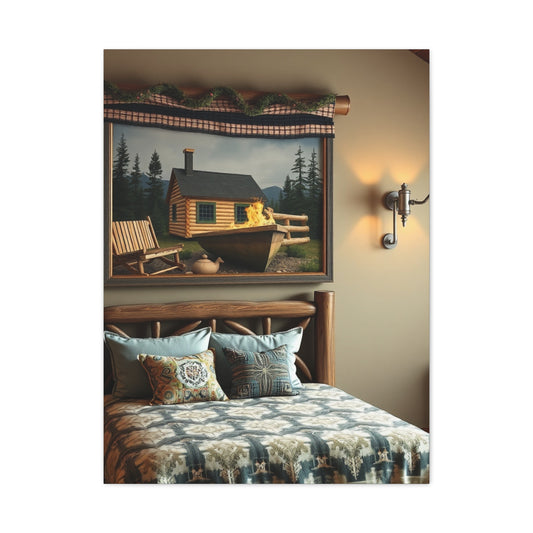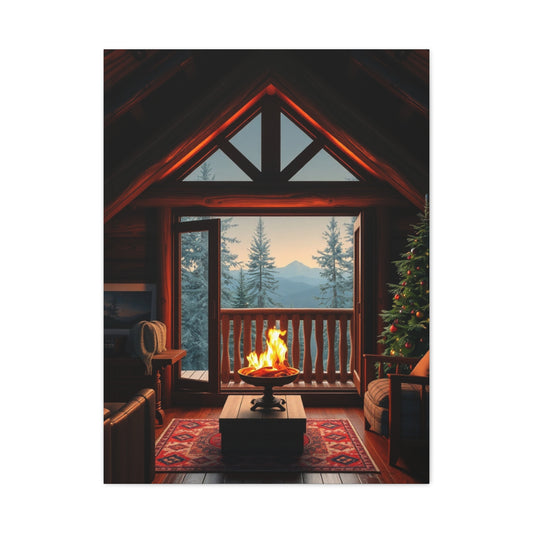Cabin Lodge Decor Wall Art: Elevate Your Space with Rustic Elegance
Creating a warm, welcoming, and visually captivating atmosphere in a cabin or lodge involves far more than selecting the right furniture or flooring. The walls of these rustic retreats play an equally critical role in defining the overall ambiance. Cabin lodge decor wall art serves as a transformative element, turning otherwise plain or underwhelming wall spaces into immersive environments that reflect the natural world, evoke serenity, and infuse the home with rustic charm. Beyond simple decoration, these carefully curated pieces contribute to the psychological and emotional comfort of inhabitants, fostering a sense of connection, nostalgia, and harmony with the surrounding environment. In spaces designed for relaxation, retreat, or recreation, the walls communicate the personality of the space as much as the furnishings themselves, making decorative choices essential in achieving a cohesive and inviting lodge aesthetic.
One of the most compelling aspects of cabin lodge wall art is its ability to bridge the gap between indoor living spaces and the natural landscapes outside. Whether a lodge is nestled among towering pines, perched on a mountain ridge, or overlooking a calm lake, interior wall art can echo these surroundings and bring elements of the outdoors inside. Handcrafted wooden panels etched with forest scenes, metal sculptures depicting deer, bears, or eagles, and artwork inspired by rivers, lakes, or mountainous terrain all work synergistically to create a sense of environmental continuity. These natural motifs are not merely decorative; they encourage a subconscious sense of calm and grounding, allowing residents and visitors to feel as if the serenity of the wilderness extends into the interior of the home.
Material choices are central to the aesthetic appeal of cabin lodge wall decorations. Earthy tones such as deep browns, muted greens, rich ochres, and soft greys create a visual harmony that complements natural surroundings while reinforcing the rustic character of the space. Organic textures like rough-hewn wood, hammered metal, woven textiles, and natural stone further enrich the sensory experience, inviting touch and enhancing the authenticity of the environment. These elements combine to produce a space that is not only visually engaging but also emotionally resonant, supporting relaxation, reflection, and a deeper appreciation of the surrounding landscape.
The versatility of cabin lodge wall art allows homeowners to tailor their spaces to reflect personal tastes while maintaining thematic coherence. Wildlife-inspired pieces may appeal to those who enjoy the rugged charm of the wilderness, while botanical illustrations, abstract natural forms, or landscape photography may resonate with individuals who prefer a more artistic or contemplative interpretation of nature. Large-format artworks can serve as dramatic focal points that draw the eye and anchor a room, while smaller pieces arranged in series or gallery-style compositions can establish a rhythmic and immersive aesthetic across expansive walls. These arrangements allow cabin owners to curate a narrative that aligns with the unique story and ambiance of their retreat, reinforcing both personal identity and spatial character.
Moreover, cabin lodge wall art supports multi-sensory design approaches. Beyond visual appeal, certain pieces—such as textured wood carvings, layered mixed-media compositions, or three-dimensional metal sculptures—introduce tactility and depth that engage visitors in a more interactive manner. Lighting can further amplify the effect of these decorative elements. Soft, warm illumination, such as lantern-style sconces, recessed uplighting, or subtle accent lights, highlights textures, enhances colors, and creates inviting shadows that enhance the cozy, immersive qualities of the lodge environment.
Nature-Inspired Wall Elements
One of the most compelling aspects of cabin lodge decor is its profound connection to the natural world. Nature-inspired wall elements play a critical role in cultivating this connection, transforming interiors into spaces that feel both tranquil and immersive. Artwork that depicts forests, mountains, rivers, and wildlife has a unique ability to transport viewers to serene outdoor settings, creating a sense of calm and a gentle reminder of the beauty beyond the cabin walls. By integrating these visual cues, homeowners can evoke the essence of the surrounding environment, whether it’s a dense pine forest, a rushing river, or a tranquil meadow, enhancing the overall ambiance of their living spaces.
Botanical illustrations, abstract representations of natural forms, and wildlife photography are particularly effective for adding authenticity and sophistication to cabin interiors. Botanical prints, for instance, offer an elegant yet timeless aesthetic, capturing the intricate details of leaves, flowers, and plant structures. These prints can be displayed individually for a minimalist impact or arranged in grids or sequences to create visual continuity across a wall. Similarly, wildlife photography brings dynamic energy to a room, whether it’s a close-up of a soaring eagle, a herd of deer in misty woods, or a playful fox in a sun-dappled glade. Large-format images often serve as dramatic focal points, commanding attention while setting a thematic tone for the space, whereas smaller series of prints or canvases can establish rhythm and pattern, adding depth and visual interest without overwhelming the eye.
Abstract interpretations of nature have also gained popularity, especially in contemporary cabin interiors that blend rustic charm with modern aesthetics. These pieces often use flowing lines, organic textures, and earthy color palettes to suggest the movement of water, wind, or foliage, offering the essence of natural phenomena without literal representation. This abstraction allows for creative expression and provides a modern touch while still maintaining a connection to nature. Textured wall art that incorporates elements such as reclaimed wood, natural fibers, or layered paint techniques can further reinforce this effect, giving the impression of natural forms in motion.
Another innovative way to incorporate nature into wall decor is through three-dimensional elements. Pressed flowers or leaves encased in glass, framed branches, and sculptural representations of flora or fauna introduce tangible aspects of the natural world into indoor spaces. These pieces not only celebrate seasonal change and the beauty of organic forms but also create subtle tactile experiences that engage viewers beyond visual aesthetics. For example, a shadowbox containing a series of dried ferns or wildflowers can serve as both a decorative accent and a conversation piece, reflecting the cabin’s connection to its surrounding landscape.
Furthermore, nature-inspired wall art need not be limited to realistic depictions. Mixed-media installations that combine photography, painting, and sculptural materials can evoke forest canopies, flowing streams, or mountain peaks in unique ways. Such versatility allows homeowners to tailor their choices to the specific mood or theme they wish to establish—be it the calming serenity of a riverside retreat, the rugged majesty of alpine landscapes, or the whimsical charm of woodland creatures. By thoughtfully selecting pieces that resonate with both the environment and personal aesthetic preferences, cabin interiors can achieve a harmonious balance between sophistication, comfort, and natural authenticity.
Ultimately, nature-inspired wall elements do more than simply decorate walls; they cultivate a sensory connection to the outdoors, enhancing the cabin experience in ways that furniture and flooring alone cannot. Whether through large-format photographic landscapes, intricate botanical illustrations, abstract organic forms, or three-dimensional natural specimens, these pieces bring the serenity, rhythm, and beauty of nature indoors. In doing so, they help transform a cabin lodge from a mere structure into a nurturing, immersive retreat, where every glance at the walls can inspire calm, reflection, and a renewed appreciation for the natural world.
Reclaimed Wood Features for Rustic Authenticity
Reclaimed wood features are among the most cherished elements in authentic cabin lodge decor, serving as both aesthetic highlights and functional components of interior design. Utilizing reclaimed wood—from old barns, decommissioned construction materials, or driftwood collected from nearby lakes and rivers—infuses cabin interiors with warmth, character, and a tangible sense of history. Each piece of reclaimed wood carries its own story, whether it’s the weathered patina of barn planks, the smooth, organic shapes of driftwood sculpted by water, or the intricate grain patterns revealed through years of aging. These natural narratives make reclaimed wood a particularly compelling choice for walls, accent pieces, and functional installations, connecting indoor spaces to the environment and history that surrounds them.
Incorporating reclaimed wood into cabin lodge walls creates a striking visual impact. Driftwood sculptures, for example, serve as captivating focal points that celebrate the artistry of nature itself. Large, twisted driftwood branches can be mounted directly on walls to form abstract, sculptural compositions, while smaller pieces can be arranged into wall-mounted art installations that highlight texture, movement, and organic flow. These sculptural elements are ideal for living rooms, entryways, or lounge areas, where they can capture attention and spark conversation, all while reinforcing a connection to natural surroundings.
Functional reclaimed wood features are equally impactful, providing practical storage or display solutions that double as decorative elements. Wall-mounted shelving systems crafted from salvaged wood seamlessly combine utility with visual appeal. These shelves can display books, nature-inspired collectibles, framed wildlife photography, or seasonal décor, further enriching the cabin lodge aesthetic. Reclaimed wood panels, when used as wall cladding, transform entire surfaces into warm, textured backdrops, establishing a sense of rustic authenticity that cannot be achieved through new materials. Careful selection and treatment of wood ensure that its inherent character—knots, weathered marks, and subtle imperfections—remains visible, preserving the story and individuality of each plank.
Custom wood art provides an opportunity for deep personalization in cabin lodge interiors. Geometric wall compositions, carved wildlife silhouettes, or pyrography art—where detailed imagery is burned into wood surfaces—allow homeowners to embed meaningful symbols, family names, dates, or scenic motifs into their walls. Such bespoke creations make each cabin truly unique, reflecting both personal narratives and a refined sense of rustic design. Mixed-media projects that combine reclaimed wood with metal, glass, or textile elements add further dimension and creativity, turning walls into interactive artistic statements.
Beyond their aesthetic and storytelling qualities, reclaimed wood elements offer environmental and sustainability benefits. By repurposing materials that would otherwise be discarded, homeowners contribute to resource conservation and reduce the ecological footprint of their interior design projects. This eco-conscious approach aligns naturally with the ethos of cabin and lodge living, where appreciation for the natural world and its preservation is central.
Reclaimed wood features integrate harmoniously with other rustic cabin lodge décor, such as leather furniture, woven textile wall hangings, or metal accents. This careful layering of natural materials enhances visual cohesion while reinforcing the theme of nature-inspired authenticity. Lighting further elevates the effect: strategically placed sconces, uplights, or pendant lamps can highlight grain patterns, textures, and sculptural details, creating dynamic interplay between light and shadow that intensifies the cozy and inviting atmosphere.
Personalized Gallery Arrangements
Creating a personalized gallery wall is one of the most effective ways to infuse a cabin lodge with character, narrative, and visual interest. Unlike single statement pieces, gallery walls allow homeowners to curate multiple artworks and decorative elements in a single cohesive display, offering both versatility and depth. By thoughtfully combining framed photographs, paintings, metal accents, and even natural specimens such as pressed leaves, pinecones, or driftwood, a gallery wall transforms ordinary walls into dynamic focal points that draw the eye and invite closer inspection. Each element contributes its own texture, color, and story, yet together they form a harmonious visual narrative that reflects the personality and experiences of the cabin’s inhabitants.
The process of designing a gallery wall begins with careful planning and preparation. Measuring wall space accurately is essential to ensure that the arrangement fits the intended area without overwhelming it. Homeowners should consider the height at which the center of the gallery will sit, the spacing between individual pieces, and the overall shape of the layout—whether symmetrical, asymmetrical, grid-like, or freeform. Experimenting with paper cutouts, masking tape, or digital design tools can help visualize potential arrangements before committing to hanging, reducing the risk of imbalance or clutter. Additionally, coordinating color palettes and frame styles enhances cohesion. For instance, using frames in similar materials or tones can unify a diverse collection of artwork, while alternating textures—such as glossy photographs with matte paintings or metallic accents—adds visual intrigue without creating chaos.
Lighting plays a crucial role in elevating the impact of a gallery wall. Properly positioned wall sconces, picture lights, or track lighting can highlight textures, emphasize focal points, and create subtle shadows that enhance depth. Warm-toned lighting complements the earthy, rustic ambiance often found in cabin interiors, while adjustable fixtures allow homeowners to direct attention to seasonal or feature pieces. By integrating lighting, a gallery wall becomes more than a static display; it transforms into a dynamic, atmospheric element that evolves with the time of day and natural light conditions.
One of the unique advantages of gallery walls is their adaptability over time. Seasonal rotations maintain visual freshness and allow the space to reflect changes in the surrounding environment. For example, during autumn, prints or photographs featuring fall foliage can replace summer landscapes, while winter might highlight snow-covered forests or cozy interior scenes. Similarly, incorporating personal photography, achievements, or locally sourced artwork imbues the space with intimacy and meaning. Each piece tells a story, whether it’s a family hiking trip, a collection of handmade crafts, or the work of a local artisan, giving visitors insight into the cabin’s character and the people who inhabit it.
Beyond aesthetics, personalized gallery arrangements foster a sense of connection between interior spaces and the outdoors. Including natural specimens, botanical prints, or wildlife images reinforces the cabin’s relationship with its surroundings, creating continuity between indoor and outdoor experiences. Mixed-media approaches, such as pairing photographs with pressed flowers, metal sculptures, or carved wooden elements, further enhance this tactile and visual connection, inviting viewers to engage with the wall on multiple sensory levels.
Finally, a successful gallery wall balances creativity with intentionality. While eclectic arrangements allow for freedom of expression, it’s essential to maintain harmony through consistent themes, complementary colors, and balanced spacing. This careful orchestration ensures that the wall does not feel cluttered or overwhelming, but instead serves as a cohesive visual story that enriches the cabin’s atmosphere. Personalized gallery arrangements ultimately elevate cabin interiors from functional spaces into immersive environments, blending art, nature, and personal narrative in ways that are uniquely expressive, dynamic, and enduring.
Vintage and Nostalgic Accents
Incorporating vintage and nostalgic accents is an essential strategy for adding warmth, character, and storytelling to cabin interiors. These elements serve as tangible connections to the past, imbuing a space with history while complementing the rustic, natural aesthetics commonly found in lodges and retreats. From weathered signage to antique advertisements and retro decorative objects, each piece contributes a unique sense of heritage, transforming walls and corners into curated displays that engage the imagination and evoke a sense of nostalgia.
Vintage signage, in particular, carries a distinct charm that enhances the cabin experience. Faded metal signs, hand-painted wooden boards, and enamel advertisements often feature typography, graphics, and color schemes that are instantly recognizable from bygone eras. When thoughtfully integrated into wall arrangements, these signs provide both visual interest and historical context. For example, a collection of vintage travel or camping signs can celebrate the spirit of adventure, while old-fashioned advertisements for local products or outdoor gear can serve as subtle storytelling devices, reflecting the regional culture or historical commerce of the area. These elements act as visual anchors, grounding modern interiors in heritage and reminding visitors of the enduring legacy of simpler, slower-paced lifestyles.
Antique decorative pieces, such as rustic mirrors, old clocks, carved wooden sculptures, or vintage lighting fixtures, can further enrich cabin interiors. These items often showcase craftsmanship, materials, and design styles that are difficult to replicate in contemporary production, lending authenticity and uniqueness to the space. Incorporating such accents alongside contemporary furniture or neutral backdrops creates a layered aesthetic, where old and new coexist harmoniously. This juxtaposition enhances the visual narrative of the cabin, making the environment feel curated rather than manufactured.
Retro decorative elements extend beyond signage and antiques to include objects that celebrate hobbies, lifestyles, or regional history. Items like vintage hunting trophies, fishing equipment, or antique ski paraphernalia not only complement the outdoor theme but also provide personal and cultural context. Displaying these pieces can tell stories about local traditions, seasonal activities, or the past experiences of the cabin’s owners or community, fostering an intimate connection between the space and its inhabitants. Even replicated rustic items, carefully chosen to match the cabin’s aesthetic, can achieve a similar effect, ensuring continuity in design while preserving the charm of history.
The use of vintage and nostalgic accents also allows for creative layering and arrangement. Grouping items in thoughtful compositions—such as gallery-style arrangements of antique signs, framed memorabilia, or collections of small historical objects—can create dynamic focal points without overwhelming the room. Alternating textures, from distressed metals to aged wood and patinated leather, enhances tactile interest and adds depth to wall and shelf displays. Lighting further amplifies the effect, highlighting textures, patinas, and unique details, while casting warm, inviting shadows that evoke the cozy ambiance of a classic lodge or cabin retreat.
Creating Comfortable Environments
Few interior design approaches evoke comfort as effectively as authentic woodland-inspired environments. Cabin-inspired decorative schemes have gained immense popularity because they do more than simply decorate a space—they create a sensory experience that resonates with warmth, serenity, and belonging. By integrating natural materials, earthy color palettes, and thoughtfully curated decorative elements, these interiors cultivate a feeling of coziness that appeals to both occupants and visitors, turning a simple structure into a retreat-like sanctuary.
At the heart of this aesthetic is the ability to replicate the subtle, calming qualities of the outdoors. Elements such as wooden beams, stone accents, mossy green textures, and nature-themed artwork provide visual cues that mimic forested landscapes. These components encourage a connection with the natural world, helping individuals feel grounded and attuned to their surroundings. Beyond their visual appeal, these elements convey a sense of permanence and stability—qualities often associated with wooded landscapes—that can make interiors feel safe, familiar, and deeply comforting.
The psychological impact of woodland-inspired decor extends well beyond mere aesthetics. Numerous studies in environmental psychology have demonstrated that exposure to nature—or even representations of nature—reduces stress, lowers blood pressure, and improves mood. Interior designs that incorporate forests, rivers, mountains, and wildlife imagery trigger subconscious associations with tranquility and relaxation, helping occupants unwind in spaces that might otherwise feel clinical or impersonal. By replicating these natural cues indoors, cabin-inspired decor fosters emotional well-being, making homes, lodges, or vacation retreats not only visually appealing but also mentally restorative.
Creating comfortable environments in cabin-style interiors relies heavily on layering both visual and tactile elements. Soft furnishings such as woolen throws, plush cushions, and leather seating complement harder textures like stone and timber, creating a balance that is inviting rather than austere. Rugs with natural fibers, handwoven blankets, and fur-inspired textures add warmth underfoot while introducing subtle patterns reminiscent of forest floors or woodland habitats. This careful interplay between hard and soft, rough and smooth, ensures that spaces feel cozy and multidimensional, appealing to both sight and touch.
Lighting is another essential factor in crafting comfort. Warm, diffused lighting mimics the natural glow of sunlight filtering through tree canopies, softening shadows and highlighting textures without creating harsh contrasts. Adjustable lighting options, such as dimmable sconces, pendant lamps, or strategically placed uplights, allow occupants to modify ambiance according to time of day or activity, further enhancing the sense of control and relaxation. Integrating natural light whenever possible—through large windows or skylights—reinforces the connection to the outdoors and improves mood by synchronizing internal rhythms with the natural day-night cycle.
Room-Specific Decoration Strategies
Woodland wall decorations offer versatile design solutions for every area within residential environments. Strategic selection and placement of appropriate decorative elements ensures each room maintains its functional purpose while contributing to overall aesthetic cohesion throughout the home.
Living Areas: Central Gathering Spaces
Living rooms serve as cabin centerpieces, requiring bold, eye-catching decorative statements that establish overall aesthetic themes. Large reclaimed timber panels featuring wildlife silhouettes, antler wall artwork, or vintage wooden signage with inspirational messaging create impressive focal points. Framed nature photography collections or rustic picture frame arrangements add personal touches. Warm lighting and textured materials including plaid throws and leather furniture complement decorative installations perfectly.
Bedroom Retreats: Personal Sanctuaries
Bedroom decorative elements should generate serene, restful atmospheres conducive to relaxation and rejuvenation. Softer, intimate pieces including wooden signage with calming messages, floral wreath displays, or macramé wall hangings work exceptionally well. Gallery walls featuring rustic frames or pressed flower artwork add charm and personality. Statement pieces above beds, such as wooden headboards with carved motifs or wildlife-themed hangings, create compelling focal points.
Kitchen Environments: Functional Spaces
Kitchens provide ideal opportunities for combining functional utility with woodland aesthetic charm. Decorative wooden shelving displays vintage kitchenware or potted herb collections, while antler or branch-shaped wall hooks accommodate utensil storage. Wooden signage featuring humorous or culinary-themed quotes adds character. Framed artwork depicting agricultural subjects reinforces rustic themes while combining practicality with visual appeal.
Dining Areas: Social Gathering Zones
Dining room decorative elements should enhance communal atmospheres while adding rustic elegance to shared meal experiences. Large wooden or metal wall sculptures featuring nature-inspired designs create impressive focal points. Vintage mirrors with distressed wooden frames make spaces appear larger while reflecting natural light. Personalized elements including framed family photography or custom family name signage create welcoming environments for conversations and celebrations.
Bathroom Spaces: Intimate Areas
Even smaller bathroom spaces benefit significantly from thoughtfully selected woodland decorative elements. Moisture-resistant materials including metal artwork or weathered wood plaques work exceptionally well. Outdoor-themed motifs featuring fish or pine tree designs maintain aesthetic consistency. Small wooden shelving accommodates candles or decorative containers, combining style with functionality.
Home Office Areas: Productive Environments
Cabin home offices require decorative elements that inspire productivity while maintaining visual appeal. Motivational wooden signage or wildlife-themed artwork above desk areas creates compelling focal points. Corkboards with rustic wooden frames provide practical functionality with aesthetic appeal. Built-in wooden wall paneling with integrated shelving displays decorative accents including antler sculptures or potted plants.
Entryway Spaces: First Impressions
Entryways establish initial impressions and require decorative elements that immediately convey cabin warmth and character. Large wooden welcome signage or functional coat racks with antler hooks combine utility with decoration. Framed mirrors with distressed finishes reflect light while making spaces appear larger. Complementary furniture including small shelves or benches adds practical functionality.
Budget-Conscious Woodland Decoration Solutions
Exceptional woodland wall decorations need not require substantial financial investments. Many popular rustic artistic elements offer remarkable beauty at accessible price points, making authentic cabin aesthetics achievable for various budget considerations.
Value-conscious decorative selections focus on pieces offering maximum visual impact relative to cost, emphasizing quality construction and timeless design elements that provide long-term satisfaction. Strategic purchasing during promotional periods or seasonal sales events enables acquisition of premium decorative pieces at reduced prices.
Historical Context of Woodland Decorative Arts
The tradition of woodland interior decoration traces its origins to early American frontier settlements, where practical necessity merged with aesthetic appreciation for natural materials and forms. Pioneer families utilized available resources to create functional yet beautiful living environments that reflected their connection to surrounding natural landscapes.
Traditional woodland craftsmanship techniques developed through generations of artisans who understood the inherent beauty of natural materials and their potential for artistic expression. These historical foundations continue influencing contemporary woodland decorative arts, maintaining authentic character while adapting to modern lifestyle requirements.
Material Considerations for Woodland Decorations
Selection of appropriate materials significantly impacts the longevity, aesthetic appeal, and overall satisfaction derived from woodland decorative investments. Understanding material characteristics enables informed decision-making that ensures decorative elements perform well over extended periods while maintaining their visual appeal.
Natural Timber Elements
Wood remains the quintessential woodland decorative material, offering warmth, texture, and natural beauty that synthetic alternatives cannot replicate. Different timber species provide unique grain patterns, color variations, and aging characteristics that contribute to overall aesthetic presentations. Reclaimed timber offers particular appeal through its weathered character and environmental sustainability benefits.
Proper timber treatment ensures longevity while preserving natural character. Quality finishes protect against moisture damage, insect infestation, and UV degradation while allowing natural grain patterns to remain visible and tactilely appealing.
Metal Accents and Hardware
Metal elements provide structural support, visual contrast, and functional components that complement natural timber elements beautifully. Iron, steel, copper, and bronze each offer distinct aesthetic qualities and aging characteristics that enhance woodland decorative presentations over time.
Hand-forged metalwork demonstrates superior craftsmanship through attention to detail and artistic design execution that mass-produced alternatives cannot match. Investment in quality metal components ensures structural integrity and aesthetic satisfaction throughout extended use periods.
Textile Integration
Fabric elements soften harsh lines while adding color, pattern, and textural interest to woodland decorative schemes. Natural fiber textiles including cotton, wool, linen, and jute complement organic aesthetic themes while providing functional benefits including sound absorption and thermal insulation.
Quality textile selection emphasizes durability, colorfastness, and resistance to environmental factors that might compromise appearance or functionality over time. Traditional weaving techniques often produce superior results compared to mass-manufactured alternatives.
Seasonal Decoration Strategies
Woodland decorative elements can adapt to seasonal changes through strategic accent additions and temporary modifications that maintain core aesthetic themes while acknowledging natural cycles and celebrations throughout the year.
Spring Renewal Themes
Spring woodland decorations celebrate renewal and growth through fresh color introductions and botanical element emphasis. Floral arrangements, pastel color accents, and nature photography featuring emerging vegetation reflect seasonal characteristics while maintaining essential woodland character.
Summer Outdoor Connection
Summer decorative approaches emphasize outdoor living integration and natural light optimization. Lighter color palettes, airy textiles, and aquatic-themed elements reflect seasonal warmth while maintaining cool, comfortable interior environments.
Autumn Harvest Celebrations
Fall decorative elements celebrate harvest themes through warm color palettes, agricultural motifs, and natural material emphasis. Corn, wheat, pumpkins, and changing foliage provide inspiration for seasonal decorative additions that enhance woodland aesthetic foundations.
Winter Comfort Focus
Winter woodland decorations emphasize warmth, comfort, and cozy gathering spaces through darker color palettes, plush textiles, and ambient lighting emphasis. Evergreen elements, rustic holiday themes, and fireplace focal points create inviting environments during cold weather periods.
Maintenance and Care of Woodland Decorations
Proper maintenance ensures woodland decorative elements retain their beauty and functionality throughout extended use periods. Understanding appropriate care techniques protects investments while preserving aesthetic appeal and structural integrity.
Timber Element Care
Wooden decorative pieces require regular cleaning, conditioning, and protective treatment to prevent damage from environmental factors. Appropriate cleaning products remove dirt and grime without damaging natural finishes or grain patterns. Periodic reconditioning maintains moisture content and prevents cracking or splitting.
Metal Element Maintenance
Metal components require protection from corrosion, oxidation, and environmental damage through appropriate cleaning and protective coating applications. Regular inspection identifies potential problems before they compromise structural integrity or aesthetic appeal.
Textile Care Procedures
Fabric elements require appropriate cleaning methods that preserve color, texture, and structural integrity. Different textile materials require specific care approaches that maintain appearance while preventing damage from improper treatment methods.
Creating Cohesive Woodland Design Themes
Successful woodland interior design requires careful coordination of all decorative elements to create harmonious, visually appealing environments that feel intentional rather than random or haphazard. Cohesive design themes emerge through thoughtful color palette selection, material consistency, and stylistic unity across all decorative components.
Color Palette Development
Establishing consistent color schemes provides foundational frameworks for all subsequent decorative decisions. Woodland palettes typically emphasize earth tones, natural hues, and organic color combinations that reflect outdoor environmental characteristics.
Primary color selections should dominate overall schemes while secondary and accent colors provide contrast and visual interest without overwhelming foundational elements. Successful color coordination creates visual flow throughout spaces while maintaining aesthetic interest and variety.
Stylistic Consistency
Maintaining stylistic consistency requires understanding underlying design principles that define chosen aesthetic approaches. Whether emphasizing rustic authenticity, contemporary minimalism, or eclectic personalization, all decorative elements should reflect common design philosophies and execution standards.
Quality standards should remain consistent across all decorative purchases, ensuring that individual pieces complement rather than compete with existing elements. Investment in fewer, higher-quality pieces often produces superior results compared to numerous lower-quality alternatives.
Future Trends in Woodland Decoration
Emerging trends in woodland interior decoration reflect evolving lifestyle preferences, technological advances, and environmental consciousness that shape contemporary design approaches. Understanding future directions enables informed decision-making that ensures long-term satisfaction and relevance.
Sustainable Material Innovation
New material technologies provide enhanced sustainability while maintaining aesthetic appeal and functional performance. Bio-based materials, recycled content products, and renewable resource utilization offer environmentally responsible alternatives to traditional options.
Innovation in material processing and finishing techniques expands available options while improving performance characteristics and reducing environmental impact.
Customization and Personalization
Advanced manufacturing techniques enable cost-effective customization and personalization of woodland decorative elements. Digital design tools and production methods facilitate unique creations that reflect individual preferences and spatial requirements.
Custom design services become increasingly accessible through online platforms and local artisan networks that connect consumers with skilled craftspeople.
Integration with Wellness Design
Growing understanding of environmental impact on human health and well-being influences woodland decorative element selection and arrangement. Biophilic design principles emphasize natural material utilization and organic form integration that support physical and psychological wellness.
Air quality considerations, natural lighting optimization, and stress reduction through natural environment simulation become increasingly important factors in decorative decision-making.
Conclusion
Woodland interior embellishments represent far more than simple decorative additions to residential environments—they constitute essential elements that transform houses into authentic sanctuaries reflecting our deepest connections to natural world beauty and serenity. Through careful selection, thoughtful arrangement, and quality implementation of these rustic artistic elements, homeowners create spaces that provide daily inspiration, comfort, and rejuvenation while honoring traditional craftsmanship and sustainable living principles.
The enduring appeal of cabin-inspired aesthetics stems from their ability to address fundamental human needs for natural connection, authentic beauty, and comfortable shelter. In our increasingly urbanized and digitized world, these decorative elements provide essential grounding influences that restore balance and perspective to daily life experiences. Whether implemented in traditional mountain retreats, contemporary suburban homes, or urban apartments, woodland decorative themes offer timeless relevance that transcends temporary fashion trends.
Success in woodland interior decoration requires understanding the delicate balance between rustic authenticity and contemporary functionality. The most effective installations seamlessly integrate traditional materials, time-honored craftsmanship techniques, and natural motifs with modern lifestyle requirements and technological conveniences. This synthesis creates environments that feel both historically grounded and entirely relevant to contemporary living patterns and preferences.
Quality investment in woodland decorative elements provides exceptional long-term value through durability, aesthetic appreciation, and emotional satisfaction that mass-produced alternatives cannot match. Handcrafted pieces demonstrate superior construction quality while supporting traditional artisan skills and sustainable production practices. These investments often appreciate in both monetary and sentimental value over time, becoming cherished family heirlooms that provide enjoyment for multiple generations.
The versatility of woodland decorative approaches enables successful implementation across diverse architectural styles, spatial configurations, and personal preferences. From minimalist contemporary interpretations to richly layered traditional presentations, these design principles adapt effectively to various aesthetic visions while maintaining essential natural character. This flexibility ensures that woodland decorative elements remain relevant and appealing regardless of changing design trends or evolving lifestyle requirements.
Environmental sustainability considerations increasingly influence woodland decorative selection, with reclaimed materials, local sourcing, and renewable resources providing responsible alternatives to conventional products. These sustainable approaches often produce superior aesthetic results while supporting environmental conservation and regional economic development. Consumers can feel confident that their decorative choices reflect responsible stewardship values while creating beautiful, meaningful living environments.
Professional design assistance can significantly enhance woodland decorative implementations through expert material selection, spatial planning, and installation techniques that ensure optimal results. While many homeowners successfully execute woodland decorative projects independently, complex installations or valuable pieces often benefit from professional expertise that prevents costly mistakes while achieving superior aesthetic outcomes.
The future of woodland interior decoration appears exceptionally promising, with emerging technologies, sustainable material innovations, and growing wellness consciousness driving continued evolution and refinement. These developments expand available options while maintaining essential authenticity that defines effective woodland aesthetic presentations. Consumers can anticipate increasingly sophisticated and environmentally responsible products that deliver superior performance while honoring traditional design principles.
Seasonal adaptation capabilities enable woodland decorative schemes to remain fresh and engaging throughout changing natural cycles while maintaining core aesthetic foundations. Strategic accent additions and temporary modifications acknowledge seasonal characteristics without requiring complete redesign or significant additional investments. This adaptability ensures long-term satisfaction while providing opportunities for creative expression and environmental responsiveness.
Ultimately, woodland wall decorations serve as powerful tools for creating living environments that nurture human well-being through natural beauty, authentic materials, and meaningful connections to our cultural heritage. They transform ordinary spaces into extraordinary sanctuaries that provide refuge from modern life complexities while celebrating the enduring appeal of natural world inspiration. Through thoughtful implementation of these timeless decorative elements, homeowners create spaces that truly reflect their values, aspirations, and deepest appreciation for natural beauty and authentic craftsmanship.
The journey toward creating exceptional woodland interior environments requires patience, planning, and commitment to quality that extends beyond simple decorative installation. It represents an investment in lifestyle enhancement that provides daily rewards through improved comfort, aesthetic satisfaction, and emotional connection to natural world beauty. These benefits compound over time, creating increasingly meaningful relationships between occupants and their carefully crafted living environments.
Whether beginning with modest accent pieces or undertaking comprehensive interior transformations, woodland decorative elements offer accessible pathways toward creating more beautiful, comfortable, and meaningful living spaces. The key lies in starting with clear vision, maintaining quality standards, and allowing authentic personal preferences to guide selection and arrangement decisions. Through this approach, anyone can successfully implement woodland decorative themes that provide lasting satisfaction and genuine enhancement to daily life experiences.


